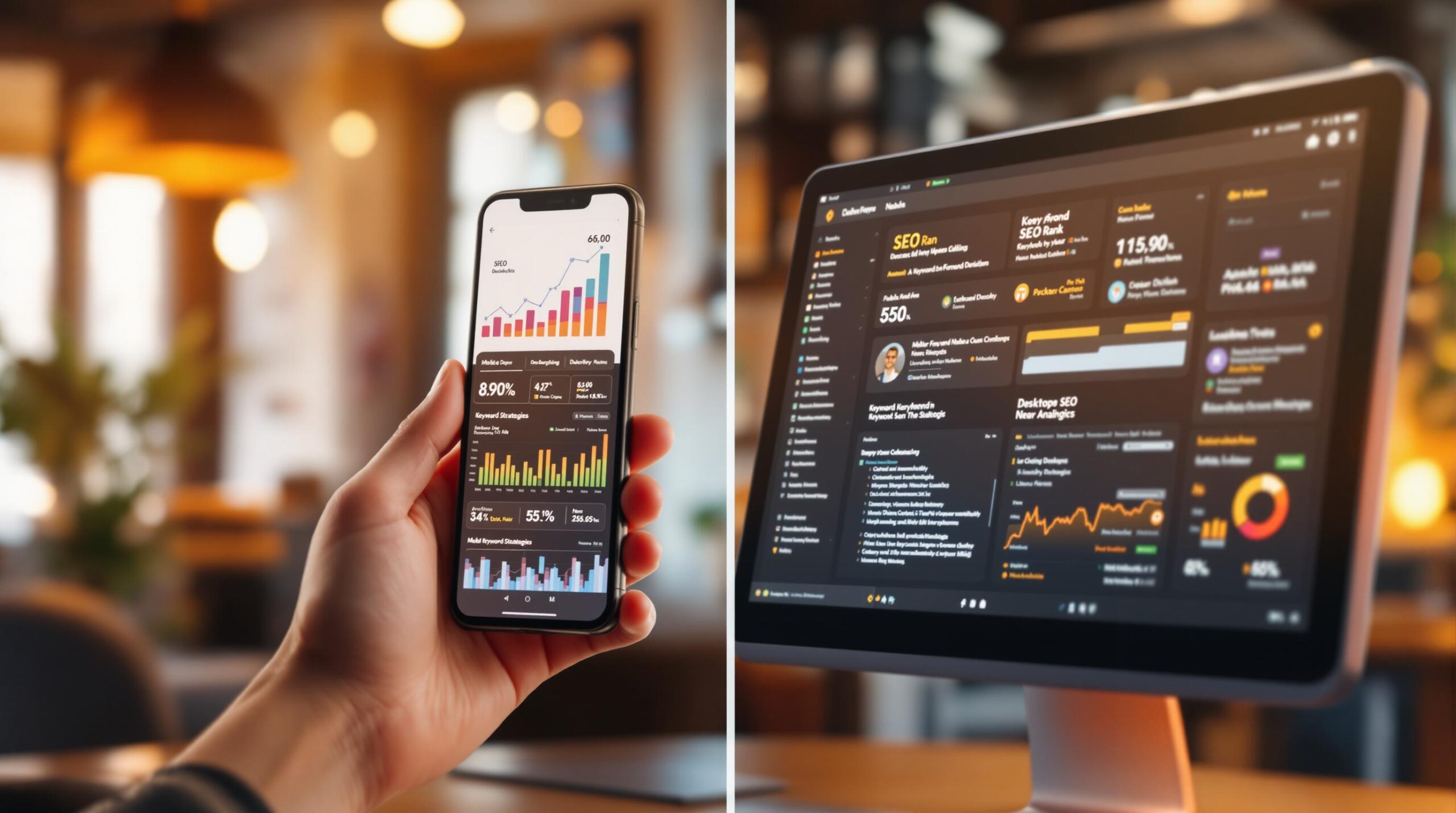Mobile and desktop rankings differ significantly due to user behavior, device capabilities, and Google’s mobile-first indexing. Here’s a quick overview of what you need to know:
- Mobile-First Indexing: Google ranks websites primarily based on their mobile version.
- Key Mobile Factors: Fast page speed, responsive design, touch-friendly navigation, and content parity with desktop versions.
- Search Intent: Mobile users prioritize quick solutions and local searches, while desktop users focus on detailed research and broader queries.
- Keyword Strategy: Use location-specific and action-oriented keywords for mobile; focus on research-heavy terms for desktop.
- User Experience: Mobile requires fast-loading, scroll-friendly pages. Desktop benefits from detailed layouts and advanced interactive features.
- Local Search: Mobile prioritizes proximity, while desktop relies on explicit location-based queries.
Quick Comparison
| Aspect | Mobile | Desktop |
|---|---|---|
| Indexing | Mobile-first indexing | Secondary to mobile version |
| Search Intent | Quick, local solutions | In-depth research |
| Keyword Focus | Location-specific, action-oriented terms | Research-heavy, detailed terms |
| Page Speed | Critical for rankings | Important, but less urgent |
| Navigation | Touch-friendly, simple | Multi-level menus, advanced interactions |
| Content Layout | Vertical scrolling, responsive design | Multi-column layouts, detailed content |
Mobile vs Desktop SEO: The Untold Truth
Search Patterns on Mobile vs Desktop
Understanding how people use search engines on different devices is key to improving rankings. Mobile and desktop searches show distinct behaviors, which can influence keyword performance and visibility.
User Goals by Device Type
Mobile users often have immediate, action-focused search habits, frequently looking for local information. On the other hand, desktop users are more likely to conduct detailed research, considering a wider variety of options. These differences shape how search engines prioritize and present content for each platform.
| Search Characteristic | Mobile Users | Desktop Users |
|---|---|---|
| Search Intent | Quick solutions and local searches | In-depth research and comparisons |
| Action Type | Fast decisions | Detailed planning and analysis |
| Location Relevance | High, with "near me" searches | Broader geographic focus |
These patterns call for adjusting keyword strategies to suit each device.
Keyword Selection by Device
To target keywords effectively, you need to consider the specific context of searches on mobile and desktop. Mobile keywords often highlight immediate needs and local intent, while desktop searches lean toward in-depth, research-heavy terms.
Here’s how to optimize:
- Mobile Keywords: Focus on location-specific, action-oriented phrases.
- Desktop Keywords: Use detailed, research-focused terms.
- Cross-Device Keywords: Identify terms that work well on both platforms.
Tailoring your keyword approach to these behaviors can help improve visibility and engagement across devices.
Device-Specific Page Optimization
Optimizing for different devices means adjusting your approach for mobile and desktop users. Mobile users need fast, responsive pages, while desktop users expect clear layouts and easy navigation.
Mobile Page Requirements
For mobile users, the focus is on creating a seamless experience on smaller screens. Here’s how to get it right:
- Responsive Design: Use fluid grids and flexible images to fit any screen size. Make sure buttons and other interactive elements are easy to tap.
- Performance: Compress images, apply lazy loading, and minimize code. Use browser caching to speed things up and ensure pages load instantly.
Desktop Page Requirements
Desktop users benefit from layouts that take advantage of larger screens. Here’s what to prioritize:
- Content Structure: Use clear navigation menus, organized layouts, and interactive features like hover effects and dropdowns. Add sections for detailed content to make the most of the extra space.
- Technical Details: Include high-resolution visuals, advanced interactive elements, and multi-column layouts. Ensure navigation works smoothly with keyboards for better accessibility.
Testing across devices is key to maintaining consistent performance and preserving your search rankings. Tailored optimization for each device type ensures a better user experience and supports search engine visibility.
sbb-itb-880d5b6
Local Search Results by Device
Local search results can differ depending on the device being used. Mobile searches tend to focus on proximity, while desktop searches rely more on specific location-based queries. Understanding these differences is key to refining your local SEO approach.
Mobile Local Search Focus
Mobile searches often prioritize results based on how close a business is to the user. People searching on their phones are usually looking for quick, nearby solutions. This means businesses physically closer to the user are more likely to appear at the top. Make sure your mobile optimization reflects this behavior.
Desktop Local Search Approach
On desktops, search results lean more on explicit location details provided in the query, rather than automatically factoring in proximity. Desktop users are often researching, so businesses show up in results when their location matches the specific terms entered.
Use these insights to fine-tune your SEO strategy for both mobile and desktop users, ensuring you’re meeting their distinct needs effectively.
User Experience Effects on Rankings
User experience has a major impact on how search engines rank websites, and this impact can differ between mobile and desktop platforms. To perform well in search rankings, it’s crucial to optimize for the unique needs of each device type.
Mobile Experience Factors
Mobile user experience is a key driver of search rankings. Here are the main factors that influence mobile performance:
- Loading Speed: Faster load times help reduce bounce rates and align with Core Web Vitals.
- Touch-Friendly Design: Interactive elements should be easy to tap and designed to avoid accidental clicks.
- Content Accessibility: Mobile content should be easy to read and navigate without zooming or horizontal scrolling. Use readable fonts, strong contrast, and layouts that fit smaller screens.
On the other hand, desktop users expect more detailed navigation and interaction options.
Desktop Experience Factors
Desktop optimization focuses on providing a richer, more detailed user experience. Important elements for desktop rankings include:
- Visual Hierarchy: Multi-level menus and structured layouts make it easier for users to find what they need.
- Interaction Patterns: Desktop users benefit from features like hover states, right-click options, and keyboard navigation. Advanced search and filtering tools are also helpful for more in-depth browsing.
Comparing Mobile and Desktop UX Priorities
The table below highlights the key differences in user experience priorities between mobile and desktop devices:
| UX Factor | Mobile Priority | Desktop Priority |
|---|---|---|
| Page Speed | Essential for quick loading | Important, with slightly more leeway |
| Navigation | Simple and touch-friendly | Supports complex, multi-level menus |
| Content Layout | Designed for vertical scrolling | Can use multi-column arrangements |
| Interactive Elements | Optimized for touch | Designed for precise mouse use |
| Image Optimization | Focused on fast loading | Allows for higher-quality visuals |
Each device type demands a tailored approach to meet user expectations and improve rankings.
Summary and Next Steps
Let’s take a closer look at what the shifting search landscape means for your strategy and how you can stay ahead.
Search Ranking Trends
The way people search on mobile and desktop continues to change as algorithms adapt to user behavior on each device. Mobile-first indexing remains a priority for search engines, with a strong focus on user experience. Meanwhile, desktop search still emphasizes rich content and interactive features. To succeed, you need a strategy tailored to each platform, backed by data and continuously refined.
From mobile-first indexing to local search differences and device-specific patterns, the trends we’ve discussed highlight the importance of staying flexible and responsive. These insights pave the way for improving your search strategy.
How SearchX Can Help

SearchX focuses on delivering results by improving technical SEO, optimizing content, and enhancing user experience – all customized for your business.
"You’re not paying for a checklist of tasks; you’re paying for outcomes. We’re relentless in our pursuit of success and adjust strategies based on what’s getting you results – whether that’s new tactics, shifting focus, or doubling down on winning strategies." – SearchX | SEO Agency [1]
Looking to boost your search performance? Let’s discuss how these strategies can align with your business goals.







